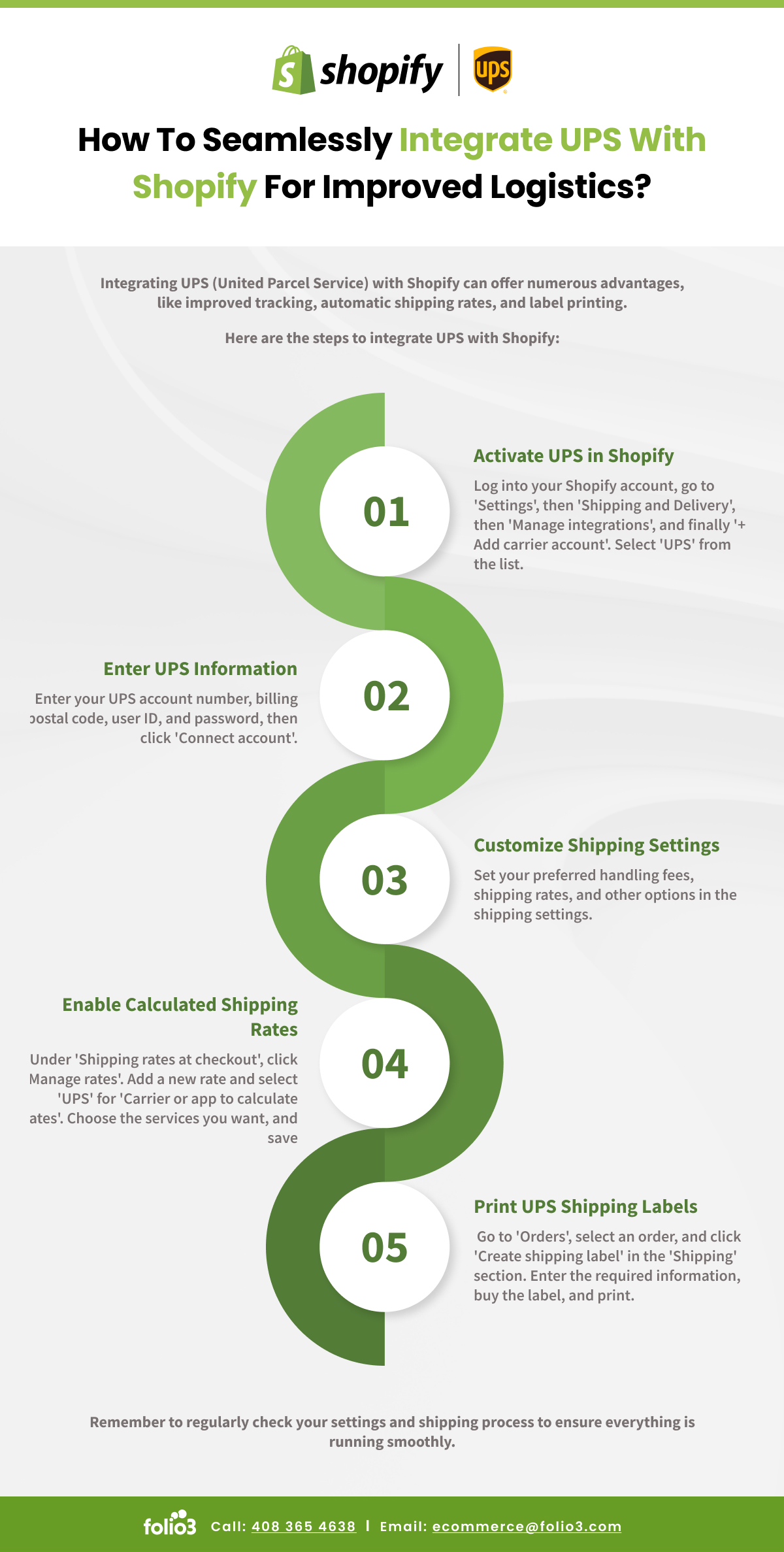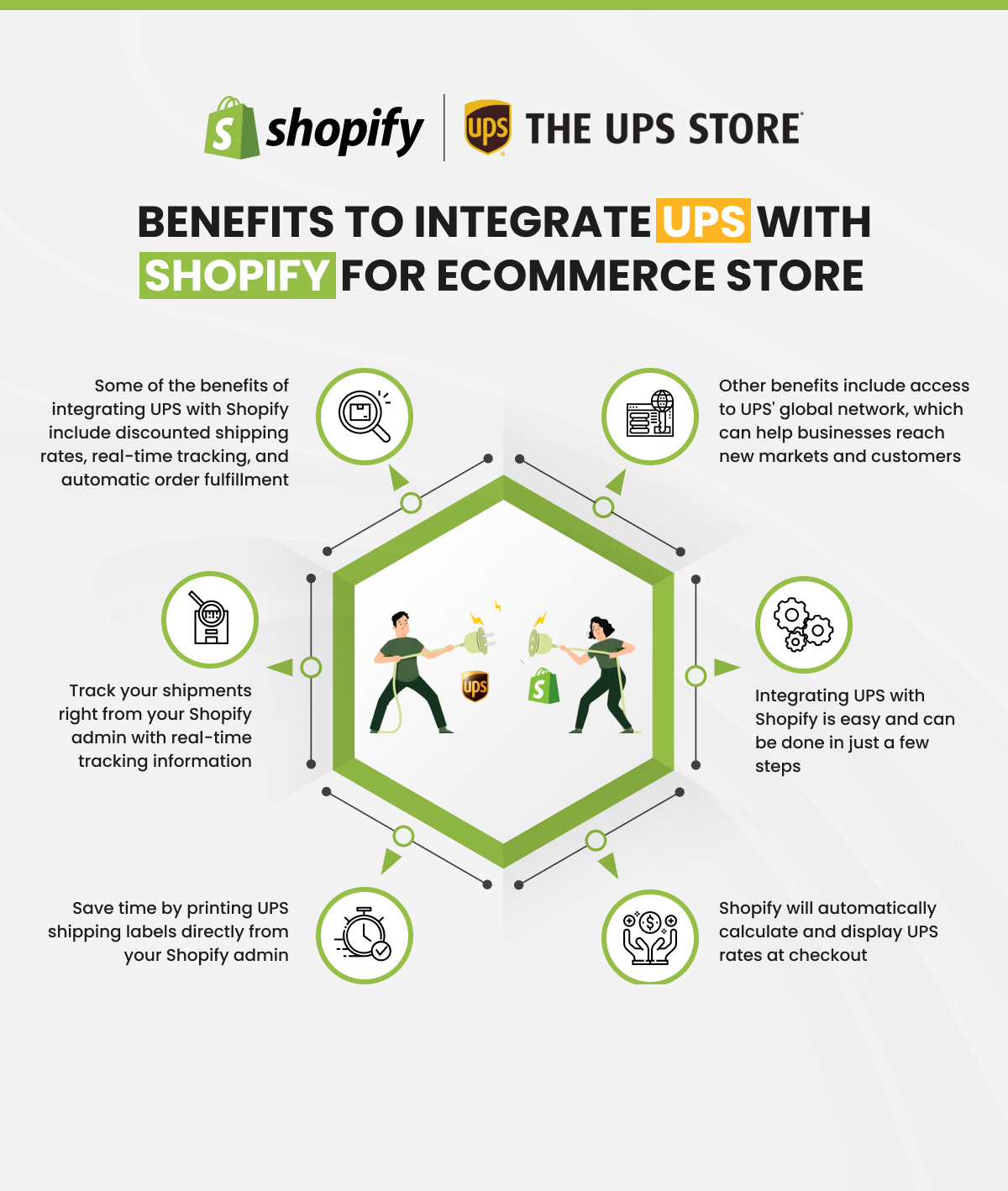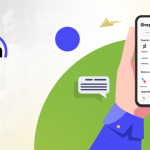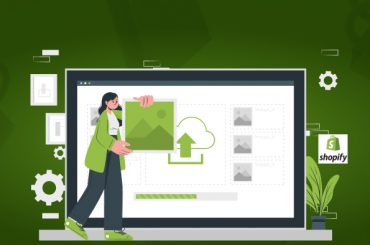Integrate UPS with Shopify – How does UPS integrate with Shopify
Last Updated | January 16, 2024
Table of Contents
UPS Supply Chain Solutions is a logistics and transportation service provider, with over 1,000 facilities in 120 countries globally. Their service offerings are concentrated in international airfreight and marine freight, customs clearance, and contract logistics. Shopify is an e-commerce platform that serves as a marketplace for online merchants and shoppers.
Shopify has more than 1.7 million active shops. It enables businesses to create a personalized shop from the ground up with no prior expertise. The average Shopify store revenue is among the highest among rivals. You may create your own store and begin selling from the site. Shopify offers stores, payment processors, and POS apps all under one platform.
Shopify also offers third-party connections to customize shop operations to meet company needs. UPS may be linked with Shopify to provide delivery services and shipping cost estimates. Even to this day, Shopify is one of the most popular online stores.
Read Also Zoho Shopify integration
How to Seamlessly Integrate UPS with Shopify for Improved Logistics
What does the UPS Shopify integration cost?
The Shopify UPS integration cost is dependent on variable factors such as the company employees, the time constraints, the skills of the developers, and the working processes. However, a rough integration cost may be expected. The integration may cost anywhere between $300- $3000 as per the store size. For a much more specific cost, you can get in contact with Folio3, and after you provide the specific requirements, our skilled business analysts will be able to give you a precise integration cost for Shopify and UPS.
Read Also Flodesk Shopify Integration
Step by Step: UPS Shopify integration method utilized by Folio3?
Folio3 can provide customized Shopify marketplace integrations solutions. They have been providing these services for over 15 years. Based on the ISO 9001 standards, they outline the step-by-step integration process for the customers. This makes sure that the solution developed is consistently well-performing. The integration method also serves as the unique selling point for the company and has crowned them as the prime Shopify development partners for stores all over the world.
- Firstly, the client will contact Folio3 and have them arrange a meeting with the Folio3 requirement engineers. Clients can contact them over the Internet, call their offices or even walk into offices for a consultation regarding the integration solution. If available, engineers can even come to the client’s office in case of urgencies.
Read Also Shopify Connector by Intuit
- The user will have a rough draft of the solution as it is expected that the user comes completely prepared. The client will specify the requirements for their UPS Shopify solution to the requirement engineers.
- The requirement engineers will record the specifications and ask the users questions regarding the solution such as the time constraints, customized requirements, or any other integration solution. The engineers will discuss their understanding with the client as well.
- The engineer will note the requirements of the client and then consult with the domain experts to outline the best solution for the customer. For example, if you want to make a store as a supplier, the requirements will vary as compared to a retail store. This analysis makes sure that the solution provided for Shopify marketplace integration with UPS. This step makes sure you are provided with the most effective solution to be utilized in customized environments.
Read Also Printful Shopify Integration
- Then, once several integration solutions are drafted, the customer will have to choose a single Shopify UPS integration solution alongside the consultation by the consultation services. Some solutions will provide direct integrations, whereas Folio3 will also provide subsidized packages that include website design for Shopify stores. These are included in packages so even the cost becomes low. The design helps fix any incompleteness and produces a very interactive user interface.
- The client will then choose a single integration solution and close the deal with the company.
- The company then asks for access to the Shopify store, the UPS account, and any relevant data required for the solution.
- The certified Shopify developers then read the system requirement specification and start to develop the solution for the solution.
- Software quality engineers then test the software to uncover bugs and glitches. The engineers perform various testing methods that are standards such as regressive testing; which makes sure that all of the functionalities are present, load testing; these help test how well the solution can handle load such as increased traffic on your store; there are deliberate tests used to understand the stability of the solution. These ensure that a mature solution is developed.
Read Also Clover Shopify Integration
- Any edits are made to the solution if required.
- The company hands over the solution to the client once the solution is ready to deploy.
- If any post-project services were a part of the package such as solution maintenance, training, and deployment are then implemented.
This step-by-step integration method is based on international standards and is safe and secure. Folio3 as a company ensures that the best working procedures are followed to the best of standards and implemented by all of the team members. Uniform processes mean that the solution delivered is in line with your business models and goals. To make your store align with the goals you can even hire services to develop a website design for Shopify. It is most preferable to hire Folio3 as they are the Shopify experts in USA and provide very affordable rates.
Read Also Magento Shopify Integration
UPS and Shopify Integration Strategies
| Aspect | UPS Integration Strategy | Shopify Integration Strategy |
|---|---|---|
| Objective | Streamline shipping and logistics | Enhance e-commerce capabilities |
| Integration Type | API-based integration | App-based integration |
| Key Features | – Real-time shipping rates | – Sync product listings |
| – Label printing | – Inventory management | |
| – Tracking and order management | – Order processing | |
| – Address validation | – Shipping rate calculation | |
| – Pickup scheduling | – Customer notifications | |
| – Returns management | – Analytics and reporting | |
| – Customizable shipping options | – Multi-channel selling support | |
| Benefits | – Accurate shipping costs | – Simplified order fulfillment |
| – Improved order tracking | – Efficient inventory management | |
| – Time-saving label printing | – Enhanced customer experience | |
| – Reduced shipping errors | – Access to a wide range of carriers | |
| – Streamlined returns process | – Scalability for growth | |
| Implementation | – Requires UPS API credentials | – Install Shopify UPS App |
| – Customize shipping preferences | – Configure app settings | |
| – Integrate with order processing | – Sync products and inventory | |
| – Set up label printing | – Define shipping rules | |
| – Test and monitor integration | – Monitor order and shipping status | |
| – Regularly update UPS API | – Ensure app compatibility | |
| Use Cases | – E-commerce businesses shipping goods | – Online stores using UPS for shipping |
| – Companies with frequent shipping needs | – Merchants looking to expand sales | |
| – Businesses with diverse shipping options | – Stores seeking automation | |
| Challenges | – API maintenance and updates | – App compatibility and updates |
| – Data security and privacy concerns | – App fees and costs | |
| – Handling complex shipping scenarios | – Learning curve for app setup |
These are some of the key aspects of UPS and Shopify integration strategies, highlighting their objectives, integration types, features, benefits, implementation steps, typical use cases, and potential challenges. Depending on your specific business needs and goals, you can choose the integration strategy that best suits your requirements.
What are the benefits of the Integration of UPS and Shopify?
The UPS and Shopify integration by Folio3 provides several benefits. You’ll get competitive rates of up to 52 percent off list pricing with UPS and Shopify Shipping, just in time for the holiday season. You may even take advantage of UPS’ guaranteed delivery date shipping choices at industry-leading rates, regardless of how big or small your company is. There are three key advantages available to you:
Shopify retailers receive unique discounts from UPS, especially for larger goods.
During the holidays, Shopify will reimburse any surge surcharges on UPS Ground shipments.
With this integration, you’ll be able to effortlessly provide your consumers with more options at lower prices through the world’s leading package delivery provider. This equals more sales and happy consumers for you. Delivery is guaranteed, and the prices are quite reasonable.
You can offer guaranteed delivery for next-day, two-day, and even three-day domestic goods.
In Shopify Shipping, you now have a variety of foreign carrier alternatives. With UPS, you may pick between UPS Standard to the destination and UPS Worldwide Express for guaranteed international delivery. Furthermore, Shopify provides direct access to all of these UPS services. Regardless of where you ship to, you can rest assured that your package will reach you on time. UPS will be the most cost-effective delivery option if you’re mailing anything heavy.
Everything you need to know about shipping is all in one platform.
More shipping options don’t imply more work for you now that UPS is integrated into Shopify Shipping. You have additional carriers and delivery speeds to choose from, allowing you to better serve your consumers. Regardless of whose delivery provider or speed you choose, you can order and print shipping labels in Shopify and manage fulfillment in one location. You can even link systems to third-party logistics suppliers that are suitable. Customers will be able to choose from UPS’s selection of shipping services and costs based on when they need their purchase to arrive and how much they want to pay if you decide to offer customer-facing UPS shipping options.
These benefits make it a must to have UPS delivery services for your Shopify store. If you have a UPS account but not a Shopify store, you can perform Shopify data migration to shift your store to Shopify.
How does the Integration of UPS and Shopify work?
The Shopify and UPS integration is able to seamlessly work together. The store owners can integrate UPS with Shopify to fully automate the order fulfillment process which helps decrease operational costs and increases productivity. It works by including the display of UPS rates at checkout for customers and at the end of the store owners. Also, printing UPS shipping labels in bulk from the merchant dashboard, and fulfilling Shopify orders with UPS tracking numbers is possible as all of these processes are linked. Rates may be compared and labels can be printed. Ship your items using the most cost-effective shipping options. Notify customers about shipments. Clients are automatically notified of every step of the delivery process in eight languages. Make your return process more automated. To encourage clients to return, provide them with pleasurable return experiences.
What benefits Folio3 offers with UPS shopify integration?
Shopify marketplace integration with UPS is a very good strategy to follow for Shopify’s business model. However, you must make sure that this process is carried out by the best Shopify development agency to ensure that the process is optimal. The benefits of Shopify marketplace integration with UPS implemented by Folio3 will be beneficial for your integration because:
- The company has certified Shopify developers with hands-on experience in developing integration solutions. The developers make use of efficient coding practices that ensure that the final product is effective and efficient.
- The developers have the ability to reduce redundant code and increase code reusability. This makes the code optimal, decreases bugs, decreases power consumption, and works fluidly. This makes the final product versatile and decreases operational and development costs.
- Expert database engineers can optimize the database and perform caching and hashing which will help reduce data dependencies and repetitiveness and result in a big decrease in data storage resources. This also makes data processing quick and effective.
- Their professional requirement engineers have the skills to develop effective system requirement specifications. This means they extract exactly what the client wants and formulate it effectively to make sure that the company builds the right product for you. This decreases any rework costs and allows for timely solution delivery.
- Domain experts perform the best analysis for the solutions by considering factors such as business requirements, projections, and relevant details.
- Software quality engineers perform various testing methods that are standards such as regressive testing; which make sure that all of the functionalities are present, load testing; these help test how well the solution can handle load such as increased traffic on your store; there are deliberate tests used to understand the stability of the solution. These ensure that the solution is error-free.
- The project managers have the skill to expertly plot out the timelines and then deliver a working solution well before the deadline. This increases work traceability and provides task completion estimates as well. These timely deliveries ensure that any delays are prevented.
- Folio3 provides after-project services to clients to maintain the store and keep updating them as per trend changes and fixing bugs.
- Perhaps the most crucial benefit Folio3 provides is the availability of affordable packages for clients. These packages are the ideal all-in-one solutions that are available at subsidized rates and have the capacity to increase return on investment rates by up to 100%.
It is safe to say that Folio3 is undoubtedly the best Shopify development partners one could hope to have. They the exclusive resources and extensive experience in the field of e-commerce. This makes sure that the UPS Shopify integration solutions they develop are the most effective. You can even go over their Shopify Saudi Arabia pricing article to get an idea of their expertise and affordable prices.
What are the UPS and Shopify integration features which are implemented?
The features of Shopify marketplace integration with UPS by Folio3 as your Shopify development partners are:
Automate UPS shipping on your Shopify store completely. You can integrate UPS with Shopify in order to fully automate the order fulfillment processing, printing UPS shipping labels in bulk from the merchant dashboard, including displaying the UPS rates at checkout, and fulfilling Shopify orders with UPS tracking numbers. Determine how the items should be packaged automatically depending on their weight and size. While creating shipments online, this information will be submitted to UPS.
Read Also How Does Shopify Integrate With Sage
Show UPS shipping rates in real-time on your Shopify checkout page. Based on the Product Weight & Dimensions, Store Location, and Customer Location, the software displays real UPS Rates at the Shopify checkout. You can set the App to alter the UPS Shipping costs for each service according to your needs. A percentage value can be used to calculate the Rate Adjustment. The Shipping Label for Multiple Carriers Among the numerous services, choose the cheapest UPS Shipping Service automatically.
From within Shopify, pay for postage and print UPS shipping labels in bulk. The App will choose the most cost-effective UPS service or process the order based on the customer’s selections during checkout. You may now choose orders and print UPS labels. You may quickly print the UPS shipping label for a specific order, which includes the shipper and recipient addresses, as well as the tracking number and UPS service chosen.
Integrate UPS with Shopify to totally automate the order fulfillment process, which includes showing UPS prices at checkout, generating UPS shipping labels in bulk from the merchant dashboard, and automatically fulfilling Shopify orders with UPS tracking numbers.
Enable UPS tracking for all of your orders in Shopify. Select the order and request Pickup after the UPS Label has been produced. Your order will be picked up by a UPS agent without you needing to contact them directly. Select the order and mark it as shipped once the Pickup has been arranged.
Read Also Shopify Development Plan: What To Consider
This will generate the Manifest, which is a list of shipments that must be turned over to the UPS agent when your cargo is picked up. Go to the Manifest tab and click the print icon to print the manifest. When the UPS driver comes to pick up your box, hand it over to them. You even can display the UPS expected delivery days for your Shopify orders on checkout, based on the customer’s location if you use the app. You can even choose to turn Shopify store into an app to increase conversion rates.
Manage UPS domestic and international shipping for Shopify The UPS tracking number is automatically sent to the Shopify order information, and the order is marked as fulfilled. Additionally, the app delivers tracking notifications to your consumers via email. It’s simple to keep track of the status of all your orders with this tool. The App may be configured to manage UPS domestic and international shipments. As a result, you don’t need various shipping options for your Shopify site.
Best UPS and Shopify Integrations that you know when you start work with Folio3?
There are multiple UPS Shopify apps to make use of such as UPS small package quotes, UPS plugin, and Pluginhive’s UPS shipping plugin. You can also consult the company for other logistics providers such as:
Consider Hermes, DPD, and Royal Mail for UK-based enterprises.
You can consider Lettre Suivie, Mondial Relay, and Colissimo for enterprises in France.
Consider PostNL, Budbee, Quicargo, and StoreShippers for Dutch territories. Consider SEUR and Correos for the Iberian regions.
FedEx and Deutsche Post can be used to ship to mainland Europe.
What is the easiest way to Connect UPS + Shopify?
You can connect UPS and Shopify easily by following this process:
Register a UPS account.
- First, you will visit the UPS website.
- Fill out the forms required to sign ups by using the affiliated site.
- Read the UPS Technology Agreement and then accept them and click on sign up.
- Confirm the email address in order to complete the registration process for UPS.
Find the account number.
You will have to find your account number as it depends on when and how the account was created. If you don’t have the account number, you can find it on a copy of the UPS invoice or by checking online. If you still don’t find an account number, you can register for one online. You can find your account number by following these steps:
- Log into your account on the UPS website.
- In the account menu located in the top right corner, select Payment Options, and under the My Payment methods, your account number will appear in the Number column and the account number will likely be displayed in this format 123AB4. If the account number still doesn’t appear, you will manually have to register for one online.
Register for the account number with UPS.
- Log into your account at the UPS website.
- From the account menu option in the top-right corner, select Payment Options.
- Then select the Add a payment method menu, click on Add a new Account, and select Add.
- Select the address that you want to be registered with and then click on next.
- You will enter the answers to the questions about your profile for shipping. You can now enter your account number and connect your UPS account.
Verify your address.
You will have to verify your account with the address which is registered with your account number.
- Log in to the UPS website account.
- On the top right corner of the page, select the account menu and select Payment Options.
- In the section of my payment methods, find the account and then select edit.
- Open the section for the Location address.
- You will now make use of the country and the ZIP and postal codes in this section to authorize your account.
Verify your invoice
If you receive an invoice from UPS in the past three months, then you will also have to authorize your account with either of the three past invoices. If you still haven’t received an invoice you can skip this step.
- Log into the UPS Billing Center.
- In the section of Quick Links, select the view invoice option.
- You will now select a valid invoice by clicking on the invoice numbers.
- Click on view or download invoice data.
Then you will find the following information for the UPS invoice:
- The Invoice amount will appear next to the amount due this period at the bottom of the invoice. If the amount is o, then you must use the charges for this period amount that appears below the summary of charges.
- The Invoice date, invoice number, and control ID will appear under the delivery service invoice in the top right corner of the invoice.
Connect the UPS account with your Shopify store.
You will require a UPS account and need to have a UPS invoice before connecting the UPS account to Shopify.
- From the Shopify admin panel, go to settings > shipping and delivery.
- In the section of carrier accounts, add UPS as a shipping carrier:
- If you have no prior shipping carrier accounts selected, click on Manage carriers and then click Connect account next to UPS.
- If you have a carrier added, then you will click Manage Carriers, and then click on connect account next to the UPS option.
- In the dialog box on Connect UPS, enter your UPS credentials.
- Click Submit and continue.
- On the dialog of Verify your UPS account, add your account and invoice details.
- Select and click on Submit.
You can now connect your UPS account to the Shopify store for shipment services. If you want to add UPS rates to your checkout, you will have to create carrier-calculated rates in the shipping settings. If you have any problems with the connection you can contact UPS directly for support. You could also choose to perform shopify marketplace integration with UPS to connect the platforms effectively. You can even choose to turn Shopify store into an app to increase conversion rates.
Conclusion.
You can integrate UPS with Shopify to make sure that the supply chain is managed by a world-class service provider. The advantages will be an estimation of delivery costs, delivery times, delivery methods, delivery schedule, the printing of labels and tags, and tracking of the products in real-time. It is crucial that you employ the best Shopify App development agency such as Folio3. Also, hire a website design for Shopify services to attract new customers.
FAQs
List down the best ups Shopify App?
There are multiple UPS Shopify apps to make use of such as UPS small package quotes, UPS plugin, and Pluginhive’s UPS shipping plugin. Some other best applications to make use of for Shopify store development are:
- Oberlo will help you source suppliers.
- Shopify Email will help market your products to consumers and help manage the campaigns using lists.
- ReConvert will help you design customized thank-you pages for customers.
- BetterReplay provides live recordings of Shopify sessions to see how users interact with the store.
- Advoz helps in managing social media advertising.
- Jebbit allows store owners to make quizzes to help their customers find products in the store.
- Friendly FAQ helps make build attractive pages to deal with customer queries.
- Sezzle helps with payment processing and provides plans for easy installment purchases. You can learn how to set up Sezzle on Shopify store.
- SAP can be integrated with Shopify as well. You can perform Shopify SAP integration as SAP is one of the greatest ERPs present in the market.
- Amazon can be integrated with your store to increase brand awareness. Perform Shopify Amazon integration to sell products on Amazon as well.
- SmartSEO helps automate SEO Optimization.
- Mochi to text and provide live chat support to customers on the Shopify store.
- Stocky helps optimize inventory for your physical and Shopify stores.
These best applications help manage your store and make Shopify store operations organized and better for store owners and customers. These Shopify marketplace integrations are best performed by Shopify development partners.
What is Shopify ups Worldship?
UPS World ship software allows for streamlining high-volume shipment deliveries. It processes the records from your desktop to save time by automating workflows and reducing errors. It is a full-featured Windows-based shipping software that can support multiple languages and is also available in over 100 countries. Also, it gives you access to UPS small package and freight services with complete access to these portfolios. ODBC and XML integrations allow Worldship to access import and export shipping details that are critical to your Shopify store databases. The easy-to-interact application lets store owners create shipping labels, send notifications via email, pay online, and even schedule pick-ups as per availability making this process simple, hassle-free, and easy for you and the customer. This feature once integrated with Shopify allows you to:
- Process deliveries with UPS Mail Innovations.
- Make repetitive shipments easier by adding them to your favorite selections on your Shopify profile.
- Automate the delivery process by automating and connecting Worldship to your Shopify store.
- Ship delicate, hazardous, and all sorts of products.
WorldShip is ideally designed for users who ship over 70 packages a week and need complete access to the UPS service suites or require modern features such as shipping profiles and built-in reporting. They also provide services such as UPS HundredWeight services and UPS Trade Direct as well. Shopify professional reports also provide good report generation for the business.
How to sync Shopify inventory with UPS?
Once you’ve integrated UPS with Shopify, you won’t have to manually update your inventory as often. The Shopify shop inventory will be instantly linked with your UPS account. This streamlines the procedure and conserves resources.
Once the integration is completed properly by the Shopify integration service providers, all changes made in Shopify will be reflected in the UPS inventory. If you already have a store on another platform, you may convert it to a Shopify store by doing a Shopify data migration. We do, however, urge that you hire a certified firm. Folio3 can securely migrate your business and also build up a decent design for your store because they also give website design for Shopify services. This will attract new clients to your new shop.
How Folio3 offers the best shopify UPS connection service at affordable prices in the USA, UK, Australia, Canada, and UAE?
Folio3 is able to achieve this benefit of providing affordable prices is by:
- Making use of skilled developers decreases operational and development costs.
- Reducing any reworking by making sure that the stage of requirement gathering was carried out perfectly.
- Providing an all-in-one package that is subsidized for businesses.
- Timely project deliveries so costs always remain within budget.
- Keep data flows clean and efficiently using expert database engineers to reduce resource consumption.
Is it possible to create auto Shopify accounts for UPS clients?
The interface between the Shopify store and UPS will synchronize the data repositories, allowing UPS accounts to be linked with Shopify accounts and providing a functional bi-directional flow. This will result in the creation of new accounts for each application. You may also convert your Shopify store into an app to improve the solution’s speed. Hire the best Shopify website development agency for applications like Folio3 to enhance conversion rates, make use of highly convertible themes, increase client retention factors, and for an optimally matched application.











